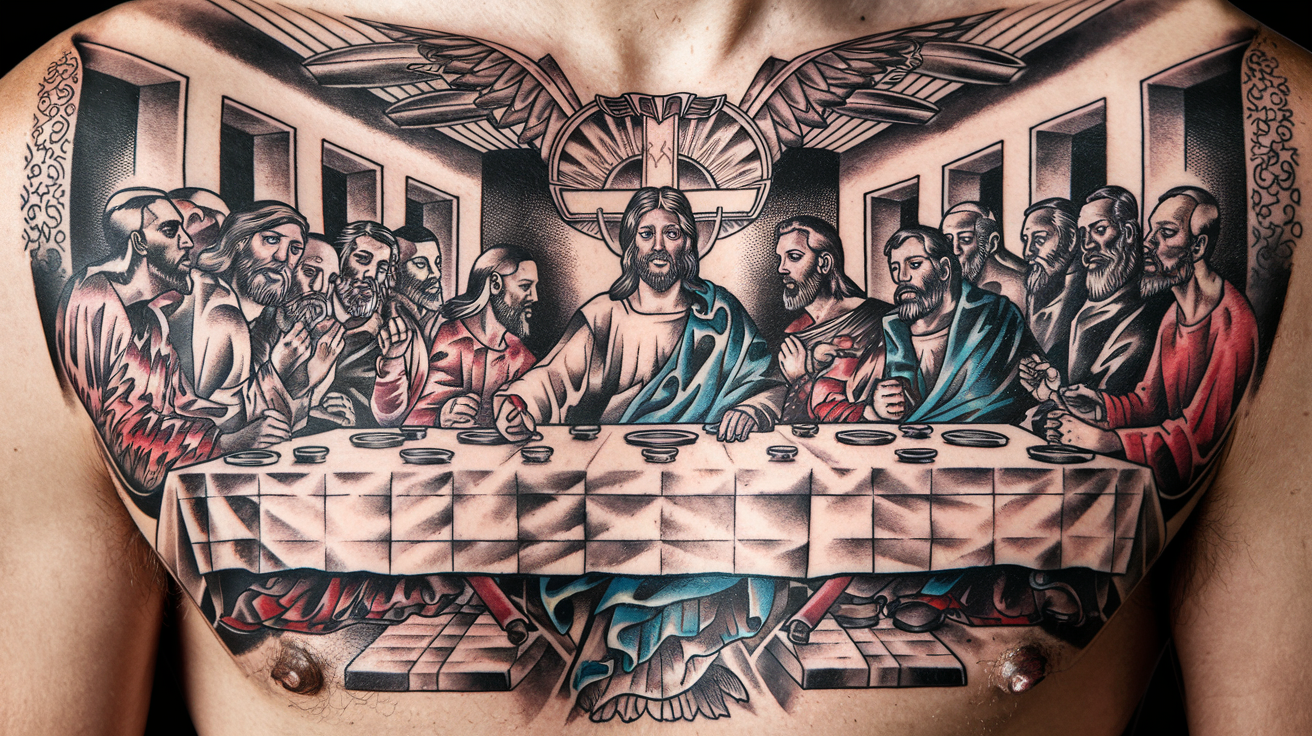As I venture into the domain of The Last Supper tattoos, I’m fascinated by the diverse creative interpretations that breathe new life into da Vinci’s iconic scene. From realistic renderings with meticulous details to modern twists that infuse the classic theme with fresh perspectives and styles, each piece is a declaration to the artist’s skill and imagination. Unconventional canvases, bold brushstrokes, and fanciful adaptations challenge traditional understanding, while abstract and expressionist variations transform the somber scene into vibrant, emotive works of art. As I continue to delve into the intricacies of these tattoos, I’m drawn deeper into a world where artistic expression knows no bounds.
Realistic Renderings of the Scene
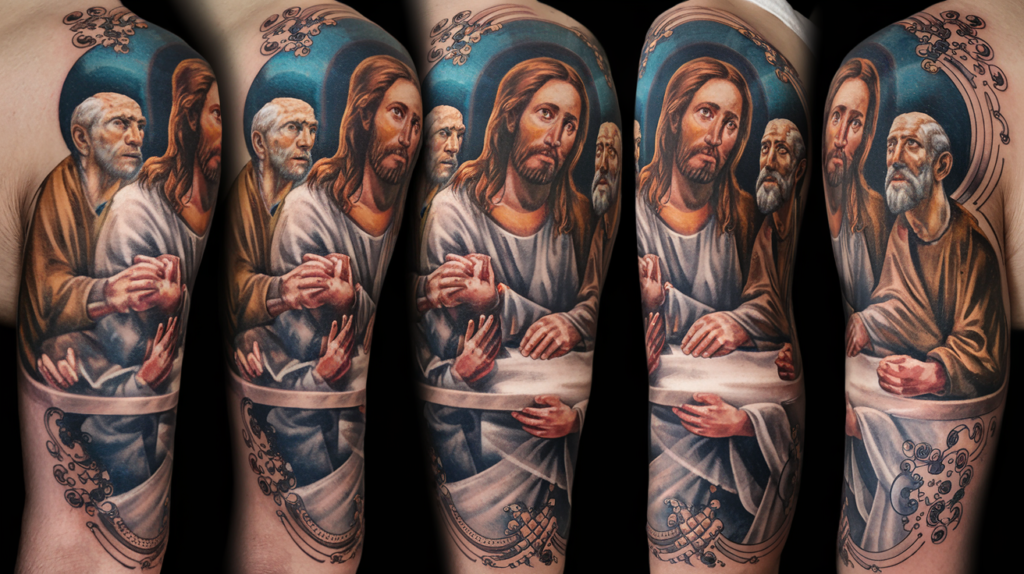
As I plunge into the domain of The Last Supper tattoos, I’m struck by the meticulous attention to detail that artists bring to their realistic renderings of the scene.
The fine details that make up this iconic masterpiece are meticulously recreated, from the folds of the apostles’ robes to the subtle expressions on their faces. However, it’s not just about reproducing the original; artists also take artistic liberties to make the scene their own.
Some add subtle shading to accentuate the emotions, while others experiment with bold colors to create a more vibrant atmosphere.
I’m particularly fascinated by the way artists balance realism with creative freedom. They must navigate the fine line between staying true to the original and injecting their own unique perspective.
The result is a stunning array of interpretations, each one an homage to the artist’s skill and vision. As I dig deeper into the world of The Last Supper tattoos, I’m struck by the level of craftsmanship and attention to detail that goes into creating these breathtaking works of art.
Da Vinci’s Influence on Tattoo Art
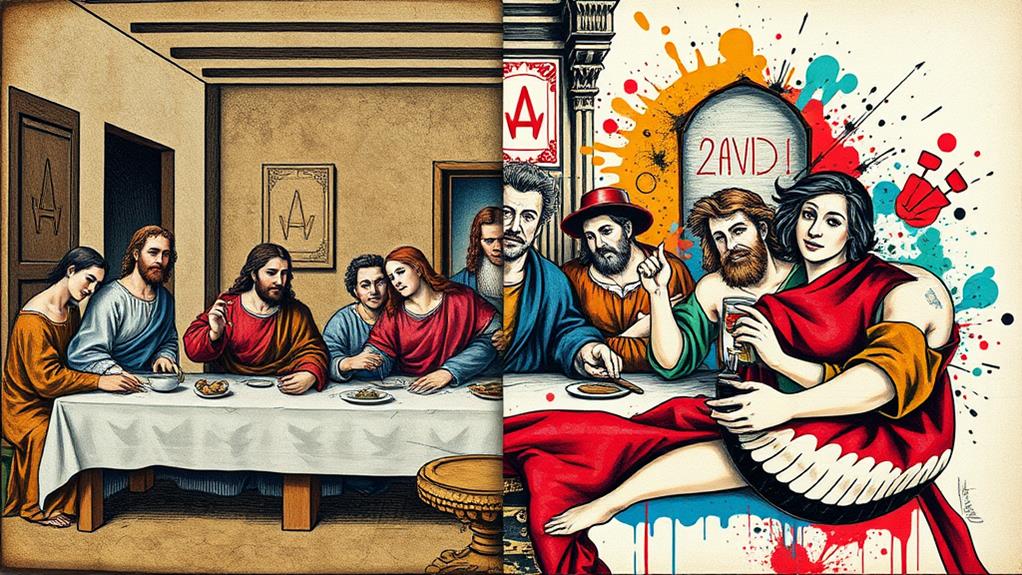
Leonardo da Vinci’s iconic masterpiece hasn’t only inspired countless adaptations in various art forms but has also permeated the world of tattoo art, leaving an indelible mark on the genre.
As I plunge into the domain of tattoo art, I’m struck by the profound influence Da Vinci’s work has had on the medium.
The Renaissance revival sparked by his masterpiece has seeped into the world of tattooing, with artists drawing inspiration from the harmony of lines, balance of composition, and emotional depth that define The Last Supper.
The artistic evolution of tattooing is deeply rooted in Da Vinci’s pioneering spirit.
His innovative use of sfumato, a technique that creates a soft, hazy effect by layering thin glazes of paint, has been echoed in the subtle shading and gradient work found in many Last Supper tattoos.
Furthermore, the emotional intensity and psychological complexity of Da Vinci’s characters have been translated into the bold, expressive lines and vivid colors characteristic of contemporary tattoo art.
As I venture into the intersection of Da Vinci’s masterpiece and tattoo art, I’m struck by the profound resonance between these two seemingly disparate art forms.
Modern Twists on a Classic Theme
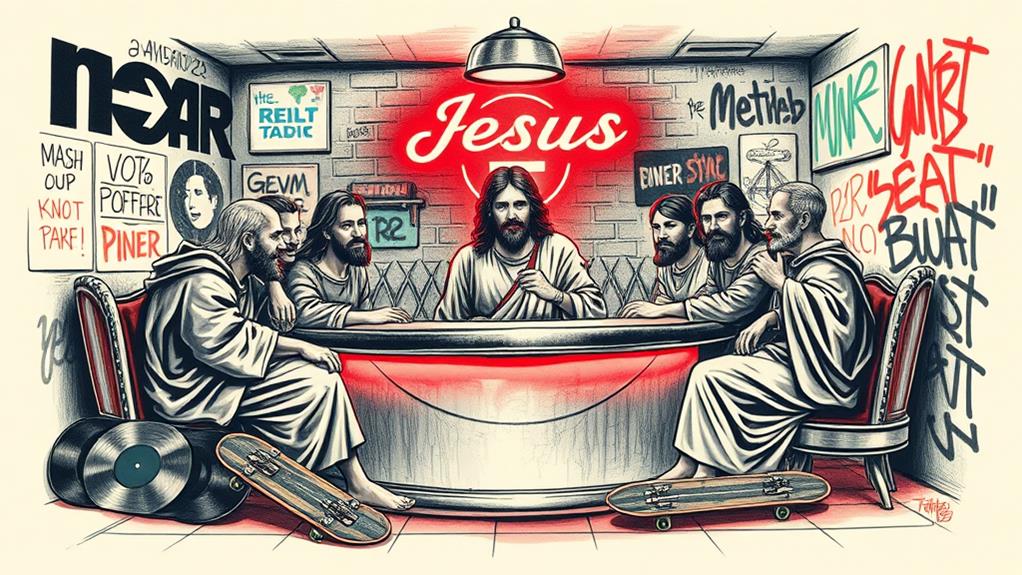
Venturing into the sphere of modern tattoo art, I’m fascinated by the innovative reinterpretations of The Last Supper, where artists boldly reimagine Da Vinci’s iconic composition, infusing it with fresh perspectives and styles.
These modern twists on a classic theme showcase the versatility of the original masterpiece, as tattoo artists take artistic liberties to create unique and thought-provoking pieces.
By experimenting with color palettes, composition, and symbolism, artists breathe new life into the centuries-old narrative.
Fresh perspectives emerge as artists incorporate contemporary themes, such as social justice, environmentalism, or personal struggle, into their designs.
The result is an enthralling blend of traditional and modern elements, where Jesus and the apostles are reimagined in bold, vibrant colors, or set against stark, urban backdrops.
These reinterpretations not only pay homage to Da Vinci’s original but also reflect the evolving tastes and values of modern society.
As I explore further into this domain, I’m struck by the endless possibilities that arise when artistic vision meets classic inspiration.
The Disciples Reimagined
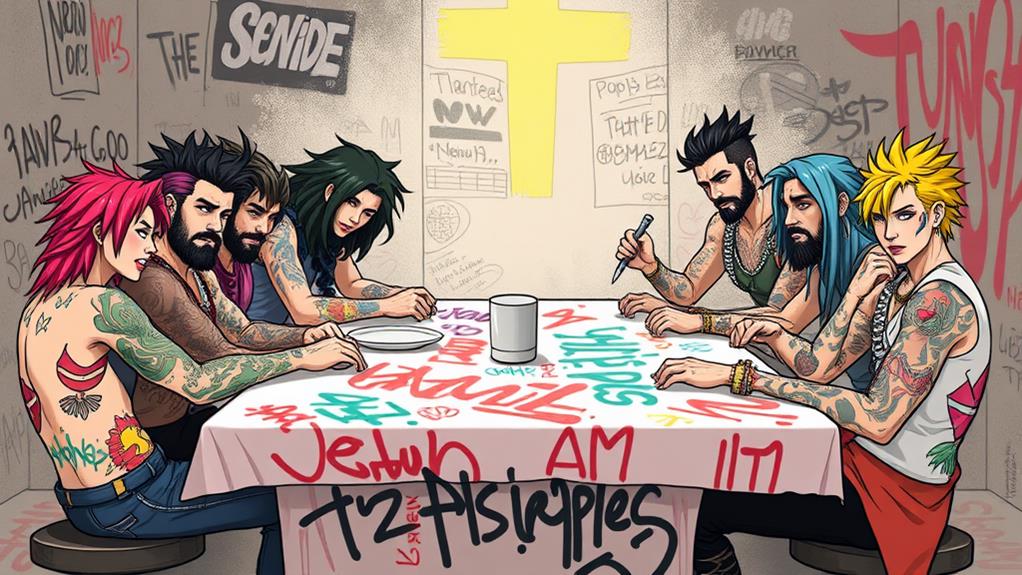
As I scrutinize the reimagined disciples in Last Supper tattoos, I’m struck by the modern apostle portraits that replace traditional Renaissance-era features with contemporary faces and expressions.
The incorporation of diverse ethnicity and identity adds a layer of complexity to the classic narrative, inviting the viewer to ponder the apostles as individuals rather than archetypes.
In addition, the disciples’ attire has also undergone a metamorphosis, trading in ancient robes for modern streetwear that injects a sense of relatability into the sacred scene.
Modern Apostle Portraits
In reimagining the apostles, tattoo artists boldly reinterpret the sacred figures, infusing them with modernity while maintaining their essence.
This reinterpretation allows the apostles to transcend time, making them relatable and accessible to a modern audience. By blending traditional Apostle personas with modern silhouettes, artists create a striking visual dichotomy that mesmerizes the viewer.
- Some artists opt for sleek, minimalist designs, stripping away ornate details to reveal the apostles’ raw emotions and humanity.
- Others incorporate bold, vibrant colors, injecting a sense of dynamism and energy into the composition.
- A few visionaries even experiment with abstract forms, fragmenting the apostles’ bodies into geometric shapes that seem to pulse with an otherworldly energy.
Through these innovative approaches, tattoo artists not only reimagine the apostles but also reinvigorate the narrative of the Last Supper, imbuing it with a fresh sense of relevance and urgency.
Ethnicity and Identity
Many tattoo artists are reenvisioning the disciples as representatives of diverse ethnicities, skillfully subverting traditional Western depictions that have dominated the art historical canon, and taking a leap into fresh perspectives.
This deliberate reinterpretation of racial identity allows artists to pay homage to their own cultural heritage, injecting a sense of personal narrative into the iconic scene. By recontextualizing the apostles as individuals from different racial and ethnic backgrounds, tattoo artists are able to reclaim and redefine the space, making it more inclusive and representative of the diverse world we live in.
I find it fascinating to see how these reinterpretations challenge our preconceived notions of the Last Supper.
The incorporation of African, Asian, or Indigenous features, for instance, serves as a powerful commentary on the erasure of non-Western cultures from art historical narratives. These tattoos not only celebrate the richness of diverse cultural heritage but also prompt us to reexamine our assumptions about racial identity and its representation in art.
Contemporary Attire
One striking aspect of these modern Last Supper tattoos is the disciples’ attire, which has been reimagined to reflect contemporary styles and aesthetics.
The artists’ creative liberties have resulted in Fashion Fusions that blend traditional garments with modern twists, creating visually striking compositions.
- A disciple donning a sleek leather jacket, paired with distressed denim jeans, adds an edgy touch to the otherwise solemn atmosphere.
- Another’s vibrant, graffiti-inspired streetwear injects a burst of urban energy into the scene.
- Meanwhile, a disciple’s elegant, flowing gown, complete with intricate lace details, brings a touch of sophistication to the table.
These Stylish Twists not only update the ancient narrative but also invite the viewer to reexamine the characters and their roles.
By recontextualizing the disciples’ attire, the artists challenge our perceptions of the characters and encourage us to ponder their personalities, backgrounds, and motivations.
This attention to detail transforms the iconic scene into a rich tapestry of diverse perspectives and experiences, making the Last Supper feel refreshingly modern and relatable.
Jesus at the Center
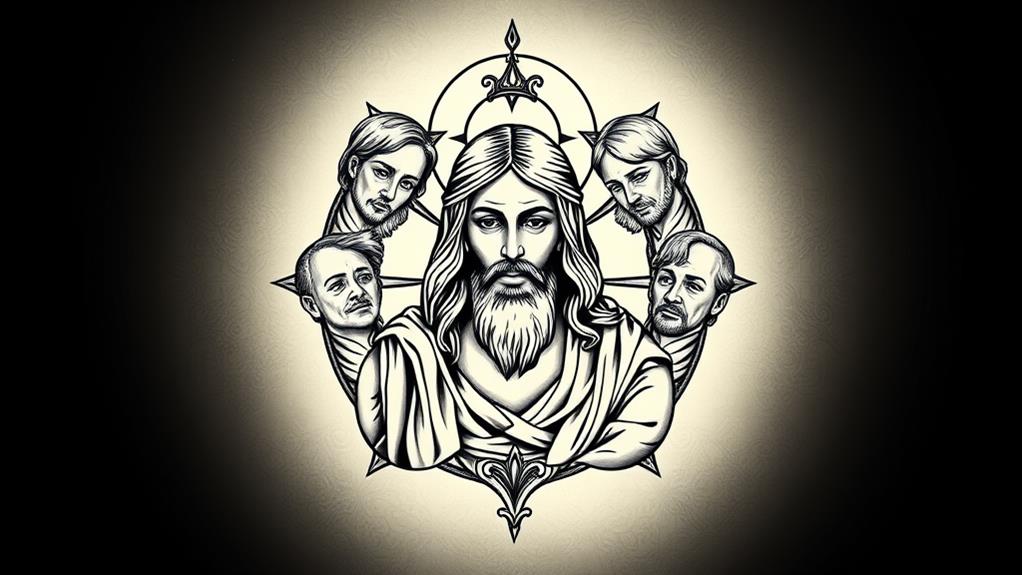
As I examine the Jesus at the Center tattoos, I’m struck by the deliberate composition that emphasizes the divine table setting, where Christ’s gentle guidance is palpable in the subtle gestures and expressions of those gathered around him.
The sacred circle formed by the apostles creates a sense of intimacy and unity, underscoring the significance of this pivotal moment in Christian history.
Divine Table Setting
During the Renaissance, when Leonardo da Vinci painted The Last Supper, he deliberately positioned Jesus at the center of the composition, flanked by the twelve apostles.
This deliberate placement of Jesus is more than just a compositional choice; it’s a statement about the significance of his presence.
In tattoo adaptations of The Last Supper, this central placement is often maintained, but with creative liberties taken to make the scene more dynamic.
When I look at these tattoos, I’m struck by the attention to detail in the Divine Table Setting.
The table itself becomes an altar, adorned with:
- Fine linens: exquisite fabrics that drape elegantly across the table, often embroidered with intricate patterns
- Candelabras: ornate holders that raise the candles, casting a warm, golden glow across the scene
- Gilded utensils: delicate, ornate forks, knives, and spoons that add a touch of luxury to the meal
The table elegance and Divine decor in these tattoos evoke a sense of reverence, underscoring the significance of Jesus’ final meal with his disciples.
As I gaze upon these tattoos, I’m reminded of the beauty and intimacy of that moment, frozen in time.
Christ’s Gentle Guidance
In juxtaposition to the ornate table setting, Jesus’ presence at the center of these tattoos exudes a sense of calm, his gentle guidance radiating outward like a lighthouse of hope.
His serene demeanor is a declaration to the Spiritual Compassion he embodies, providing comfort to those who seek refuge in his divine presence.
As the central figure, Jesus embodies Divine Mentorship, offering wisdom and direction to his disciples.
His gentle guidance is palpable, as if he’s tenderly guiding each of them towards a path of righteousness.
The subtle yet powerful symbolism in these tattoos speaks to the profound impact of Jesus’ teachings, which continue to inspire and guide generations.
The delicate balance between the ornate table setting and Jesus’ understated presence creates a visually striking contrast, underscoring the significance of his role as a spiritual leader.
Through these tattoos, artists pay tribute to Jesus’ enduring legacy, capturing the essence of his gentle guidance and Spiritual Compassion.
Sacred Circle Formed
Beyond the lavish tapestry of the Last Supper, a sacred circle forms around Jesus, its epicenter pulsing with an aura of reverence.
As I plunge deeper into the symbolism, I’m struck by the deliberate placement of Christ at the center, radiating an essence of spiritual unity.
The apostles, arranged in a deliberate arc, seem to be drawn into His orbit, their individuality dissolving into a collective whole.
- The circular formation echoes sacred geometry, where the circumference represents infinity and the center symbolizes the divine.
- This deliberate composition conveys the unity and harmony that Jesus embodies, transcending the petty squabbles and doubts that plague humanity.
- By placing Jesus at the center, the artist underscores His role as the conduit to the divine, bridging the gap between the mortal and the transcendent.
In this Sacred Circle, I sense a profound stillness, as if time itself has been suspended.
The apostles, once distinct individuals, have coalesced into a single, unified entity, their faces upturned towards Jesus, basking in the radiance of His love and wisdom.
Symbolism in Last Supper Tattoos
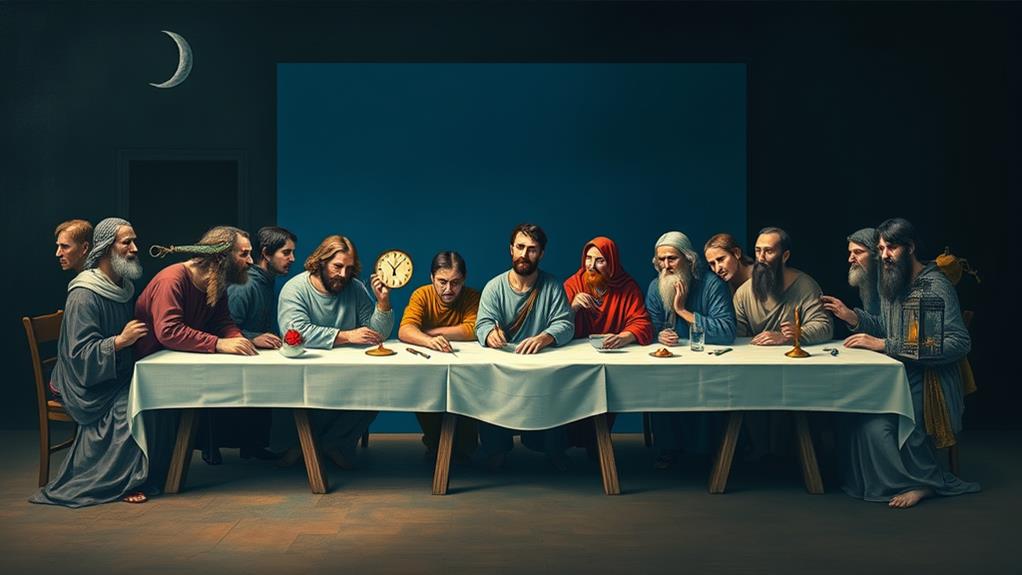
At least thirteen apostles surround Jesus in Leonardo da Vinci’s iconic masterpiece, each with their own distinct emotional response to the announcement of his impending betrayal.
As I excavate into the domain of Last Supper tattoos, I’m struck by the rich symbolism embedded within this sacred iconography.
The apostles, often depicted in various states of shock, grief, and anger, serve as a declaration to the complexities of human emotion.
The symbolic layers of the Last Supper extend far beyond the apostles, however.
Jesus, the central figure, embodies sacrifice and redemption.
The bread, often depicted as broken or torn, symbolizes the body of Christ, while the wine represents his blood.
The table, a symbol of unity and community, serves as a poignant reminder of the Last Supper’s significance.
In tattoo form, these elements can be reinterpreted to convey personal messages of love, loss, and devotion.
Unconventional Canvases and Placements
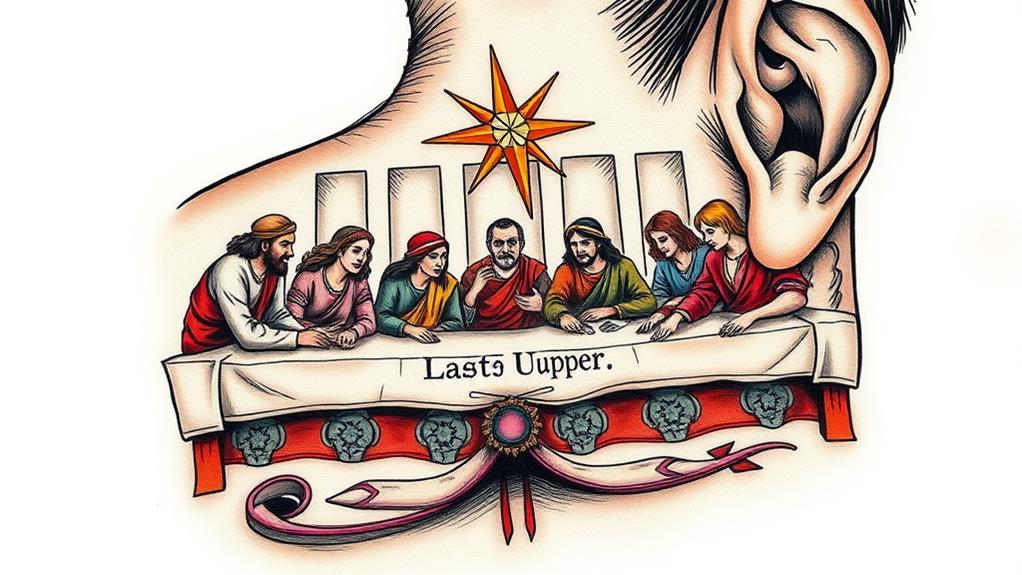
Vulnerability is etched onto the skin as tattoo artists push the boundaries of conventional canvas expectations, redefining the anatomy of art.
The Last Supper is no longer confined to traditional arm or back tattoos, but rather, it’s a masterpiece that’s boldly displayed on unlikely surfaces.
- The delicate curves of the ribcage, where the subtle nuances of Jesus’ face seem to whisper secrets to the beholder
- The tender skin behind the ear, where Judas’ betrayal is etched in fine lines, a poignant reminder of the complexities of human relationships
- The muscular expanse of the thigh, where the disciples’ faces are arranged in a mosaic of emotions, a tribute to the artist’s skill and creativity
These unexpected placements not only challenge the viewer’s perception but also invite a deeper exploration of the artwork.
As I explore into the world of unconventional canvases, I’m struck by the audacity and innovation of tattoo artists who refuse to be bound by traditional norms.
They’re rewriting the rules, and in doing so, creating masterpieces that are as thought-provoking as they’re visually stunning.
Innovative Color Schemes and Styles
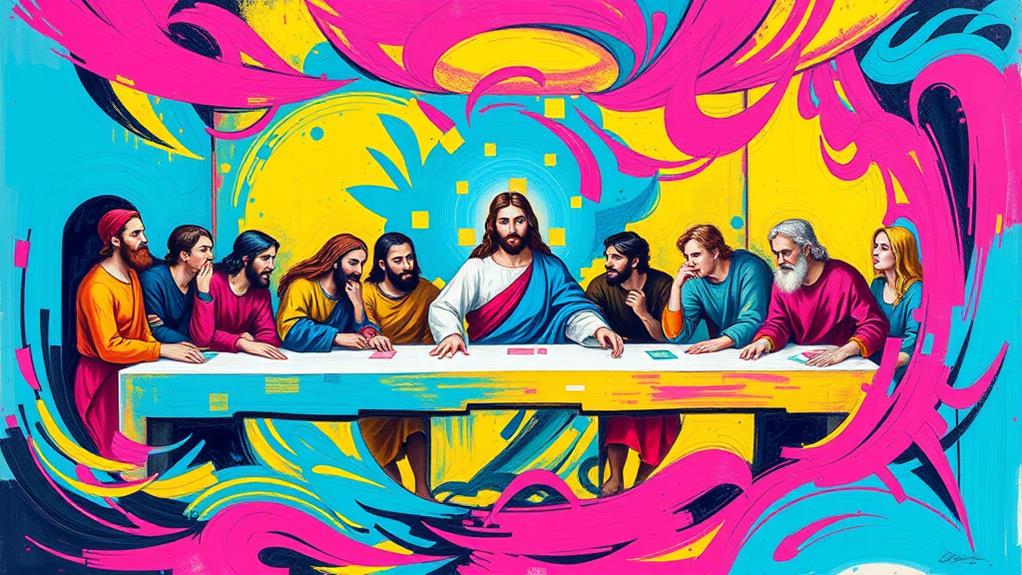
As I venture into the domain of Last Supper tattoos, I’m struck by the innovative color schemes and styles that artists employ to reimagine this iconic scene.
Vibrant hues, such as electric blues and fiery oranges, inject a modern essence into the composition, while unconventional art forms, like watercolor or abstract expressions, add a layer of complexity to the narrative.
Bold brushstrokes, meanwhile, imbue the piece with a sense of dynamism, as if the apostles are about to leap off the skin.
Vibrant Color Choices
Seven vibrant color schemes stand out in The Last Supper tattoos, each one a tribute to the artist’s creativity and skill.
These innovative color palettes enhance the iconic scene, infusing it with fresh energy and emotional resonance.
From bold and bright hues to muted, earthy tones, the range of color choices is astounding.
Some of the most striking examples include:
- Neon Renaissance: Electric blues and yellows pop against a dark, muted background, evoking a sense of modernity and edginess.
- Earthy Realism: Muted greens, browns, and tans create a natural, organic feel, as if the disciples are gathered in a rustic, outdoor setting.
- Gothic Drama: Deep, rich colors like crimson, indigo, and gold create a sense of mystery and intensity, drawing the viewer into the emotional drama of the scene.
Each of these color schemes offers a unique interpretation of the iconic Last Supper scene, demonstrating the artist’s skill and creativity in reimagining a timeless masterpiece.
Unconventional Art Forms
My fascination with unconventional art forms in The Last Supper tattoos lies in their ability to reimagine the classic scene through innovative color schemes and styles.
These avant-garde interpretations not only pay homage to Leonardo da Vinci’s masterpiece but also infuse it with a contemporary twist. I’m particularly drawn to tattoos that blend Street Art elements, such as stencils and graffiti, with Pop Culture references, creating a visually striking fusion.
For instance, a tattoo that replaces the apostles with superheroes or incorporates iconic symbols from modern culture, like the peace sign or the anarchy symbol, challenges our traditional understanding of the scene.
These unconventional art forms also experiment with bold, neon colors, geometric patterns, and abstract shapes, further distancing themselves from the original Renaissance-era depiction.
Bold Brushstrokes Matter
Incorporating innovative color schemes and styles, The Last Supper tattoos redefine the iconic scene, imbuing it with a modern essence that enthralls the viewer.
These bold brushstrokes matter, as they breathe new life into a timeless masterpiece. By experimenting with vibrant hues and unconventional techniques, artists exercise their artistic freedom, making bold statements that set their work apart.
Some notable examples of this creative liberty include:
- Neon-lit disciples: Electric blues and radiant pinks transform the apostles into a mesmerizing spectacle, as if they’re radiating an otherworldly energy.
- Watercolor whimsy: Soft, blended strokes evoke a sense of ethereal wonder, transporting the viewer to a dreamlike domain where the boundaries between reality and fantasy blur.
- Graffiti-inspired grit: Bold, staccato lines and vivid splashes of color inject a sense of urban edginess, reimagining The Last Supper as a contemporary, street-art masterpiece.
Through these innovative approaches, The Last Supper tattoos not only pay homage to the original artwork but also reflect the artist’s unique vision, ensuring that this iconic scene remains forever dynamic and thought-provoking.
Whimsical and Humorous Interpretations
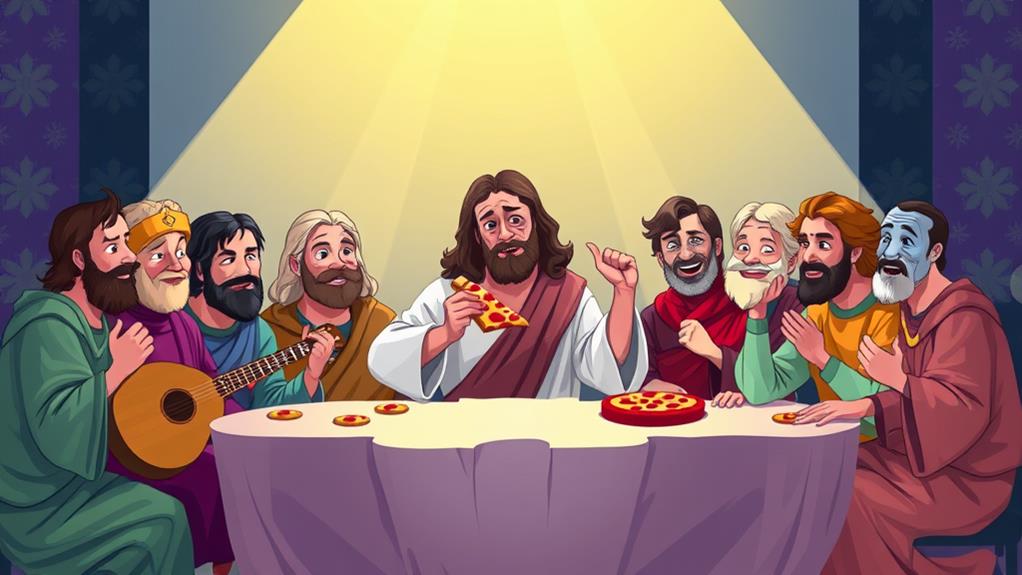
As I plunge into the domain of fanciful and humorous interpretations of The Last Supper tattoos, I’m struck by the sheer audacity of artists who dare to reimagine this sacred scene with a dash of playfulness.
Quirky adaptations abound, where apostles are replaced by cartoon characters, and Jesus is depicted as a cheerful, bearded hipster.
Playful reenactments transform the somber atmosphere of the original into a lively, fanciful gathering.
In one design, the apostles are engaged in a heated game of poker, while Jesus deals the cards with a sly grin.
Another features a food fight, with bread rolls and wine glasses flying through the air.
These unconventional interpretations not only showcase the artists’ creativity but also challenge our traditional understanding of the iconic scene.
The Last Supper in Monochrome
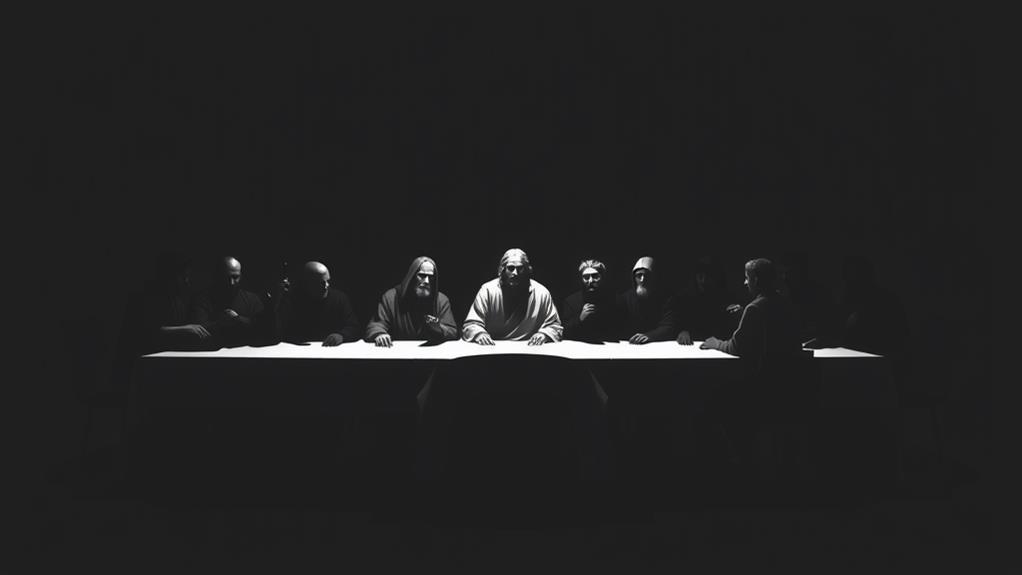
I shift my focus to the stark beauty of monochrome interpretations, where the rich tapestry of colors is stripped away, leaving only the essence of the composition.
In this domain, the Last Supper takes on a new level of sophistication, as the absence of color allows the viewer to focus on the intricate details and emotional nuances of the scene.
- The subtlety of grayscale emotion is palpable, as the gentle gradations of tone evoke a sense of introspection and contemplation.
- The apostles’ faces, once vibrant with color, now convey a sense of solemnity and reverence through the careful balance of light and shadow.
- The monochrome simplicity of the composition draws attention to the geometric harmony of Leonardo’s original, with the lines and shapes of the tableau taking on a new level of elegance and refinement.
Through the lens of monochrome, I gain a deeper appreciation for the masterful composition and emotional depth of the Last Supper.
The removal of color serves to amplify the emotional resonance of the scene, inviting the viewer to engage with the artwork on a more intimate level.
Abstract and Expressionist Variations
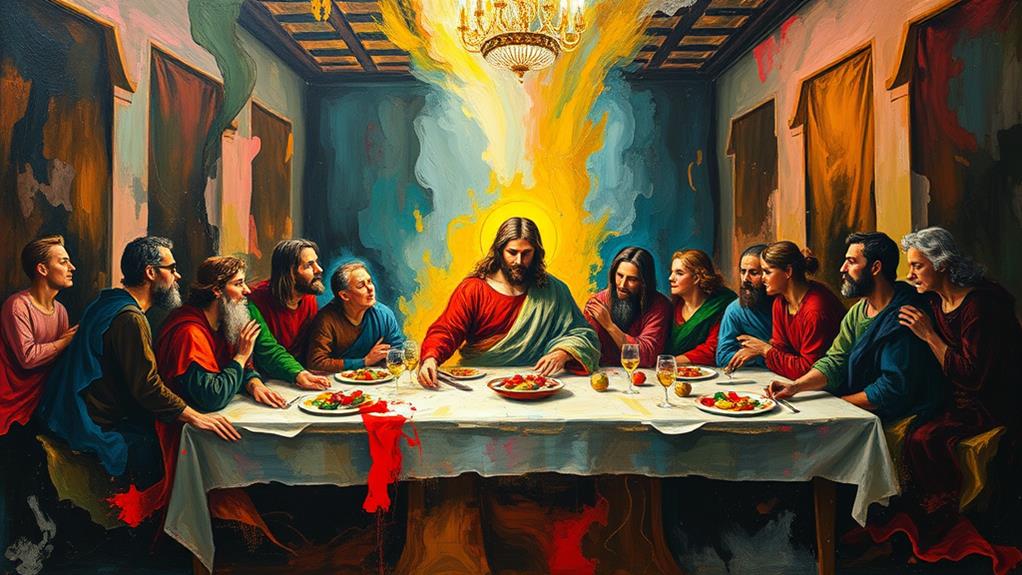
As I venture into the domain of abstract and expressionist variations of The Last Supper tattoos, I’m struck by the bold reinterpretations that shatter traditional representations.
Fragmented faces unite in disjointed harmony, while expressive brushstrokes release dynamic energy, and vibrant colors clash in a mesmerizing display of artistic license.
In these innovative designs, the boundaries of realism are pushed to the limits, yielding a fresh, avant-garde perspective on a timeless masterpiece.
Fragmented Faces Unite
While Leonardo da Vinci’s The Last Supper continues to inspire artistic reinterpretations, tattoo artists have taken the fragmented faces of Christ and his disciples to new heights, deconstructing and reassembling them in abstract and expressionist variations that unite disparate elements into cohesive, thought-provoking masterpieces.
In these innovative designs, facial fragments are reconfigured to create disjointed portraits that challenge traditional representations of the iconic figures.
The results are visually striking and intellectually stimulating, inviting viewers to reexamine their understanding of the original artwork.
Some notable examples of this trend include:
- Facial features distorted and magnified, creating an unsettling sense of unease and introspection.
- Overlapping profiles, blurring the boundaries between individual identities and emphasizing the collective nature of the Last Supper.
- Geometric patterns and shapes, infusing the portraits with a sense of modernity and abstraction, while maintaining the essence of the original narrative.
Expressive Brushstrokes Unleashed
Through the lens of abstract and expressionist variations, tattoo artists have liberated expressive brushstrokes that not only reimagine the iconic figures of The Last Supper but also tap into the emotional essence of the original masterpiece.
By taking artistic liberties, they’ve transformed the somber, realistic depiction of Jesus and his disciples into vibrant, emotive, and thought-provoking works of art.
Bold expressions of color and form dominate these pieces, as artists experiment with unconventional techniques to convey the essence of the scene.
Fragmented forms, distorted proportions, and abstracted shapes create a sense of turmoil, reflecting the emotional turmoil of the characters.
The bold, expressive brushstrokes evoke a sense of urgency and intensity, capturing the drama and tension of the moment.
In these abstract and expressionist variations, the tattoo artists have managed to distill the emotional core of The Last Supper, presenting a fresh and mesmerizing perspective on a timeless masterpiece.
Vibrant Colors Clash
I find myself drawn to the vibrant colors that clash in abstract and expressionist variations of The Last Supper tattoos, where the somber tones of the original masterpiece give way to a kaleidoscope of hues.
These artistic interpretations are a far cry from Leonardo da Vinci’s subdued palette, instead embracing a colorful chaos that’s both jarring and mesmerizing.
- Neon pinks and electric blues collide in a whirlwind of color, defying traditional representations of the sacred scene.
- Artists revel in artistic anarchy, splashing bold brushstrokes across the canvas to create a sense of frenetic energy.
- The resulting tattoos are a tribute to the versatility of The Last Supper as a subject, capable of being reimagined in a multitude of styles and moods.
As I dig deeper into these abstract and expressionist variations, I’m struck by the tension between the familiar composition and the unbridled creativity of the artists.
The contrast between the serene, solemn atmosphere of the original and the vibrant, clashing colors of these tattoos is a true marvel, one that challenges our perceptions of this iconic masterpiece.
Cultural Fusions and Inspirations
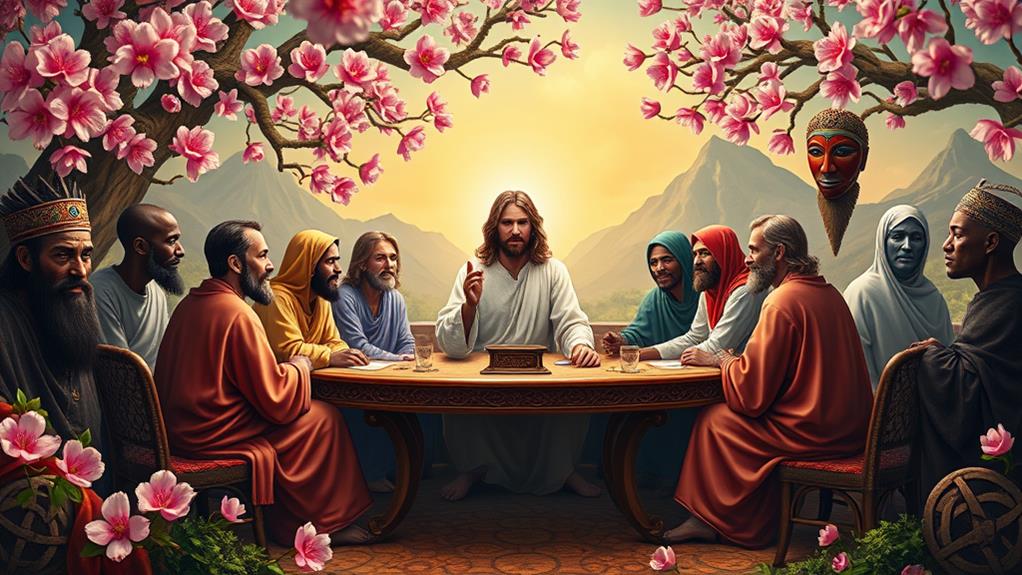
As I plunge into the domain of Last Supper tattoos, I find myself fascinated by the myriad cultural fusions and inspirations that have emerged.
It’s remarkable to see how artists have taken the iconic scene and merged it with diverse cultural and artistic traditions. One striking example is the blending of Japanese ukiyo-e woodblock prints with Renaissance-era realism, resulting in a unique visual language that’s both ancient and modern.
Another notable fusion is the incorporation of African patterns and motifs, which adds a vibrant, rhythmic quality to the composition. These artistic mergers not only pay homage to the original masterpiece but also infuse it with fresh perspectives and meanings.
I’m struck by the way cultural blending can revitalize a familiar image, making it feel both timeless and contemporary. By combining disparate elements, artists have created a new visual vocabulary that’s both unexpected and enthralling.
Minimalist Approaches to the Scene
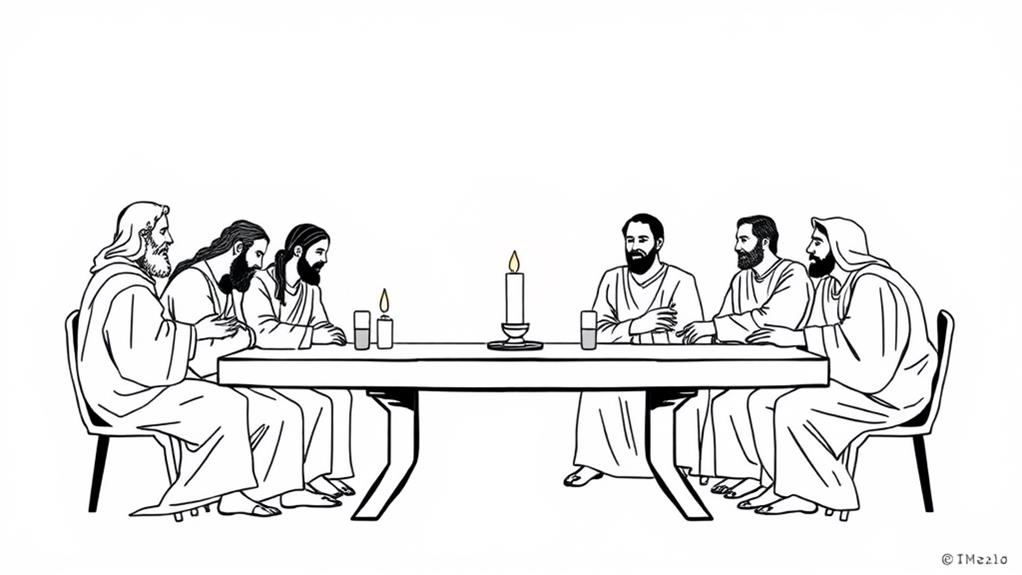
Several striking variations of Last Supper tattoos eschew elaborate details, opting instead for a minimalist approach that distills the iconic scene to its essence.
This stripped-down aesthetic allows the core elements of the narrative to shine, unencumbered by extraneous embellishments.
By paring down the composition to its most fundamental components, artists can create a sense of simplicity and understated elegance that resonates deeply with viewers.
Some notable examples of minimalist Last Supper tattoos include:
- Simple Silhouettes: Reducing the apostles and Christ to basic shapes, devoid of facial features or texture, creates a hauntingly beautiful visual shorthand that conveys the emotional weight of the scene.
- Monochromatic Palettes: Limiting the color scheme to a single hue or a narrow range of tones can imbue the tattoo with a sense of solemnity and contemplation.
- Negative Space: Using the absence of ink to define the figures and setting can create a sense of subtlety and restraint, drawing the viewer’s eye to the essential elements of the narrative.
Dynamic Compositions and Angles

Beyond the domain of minimalist approaches, Last Supper tattoos can also assume a more dynamic guise, leveraging innovative compositions and angles to inject a sense of energy and tension into the iconic scene.
I’m drawn to how artists take artistic liberties to reimagine the classic tableau. Dynamic perspectives, achieved through unusual vantage points or deliberate distortions, add a layer of complexity to the composition.
For instance, some artists opt for a bird’s-eye view, looking down upon the apostles as they gather around the table. This perspective creates a sense of vertigo, as if I’m hovering above the scene.
Others employ a worm’s-eye view, positioning the viewer at floor level, gazing up at the figures. This angle imbues the scene with a sense of grandeur, as if I’m witnessing a monumental event.
Personal Significance and Storytelling
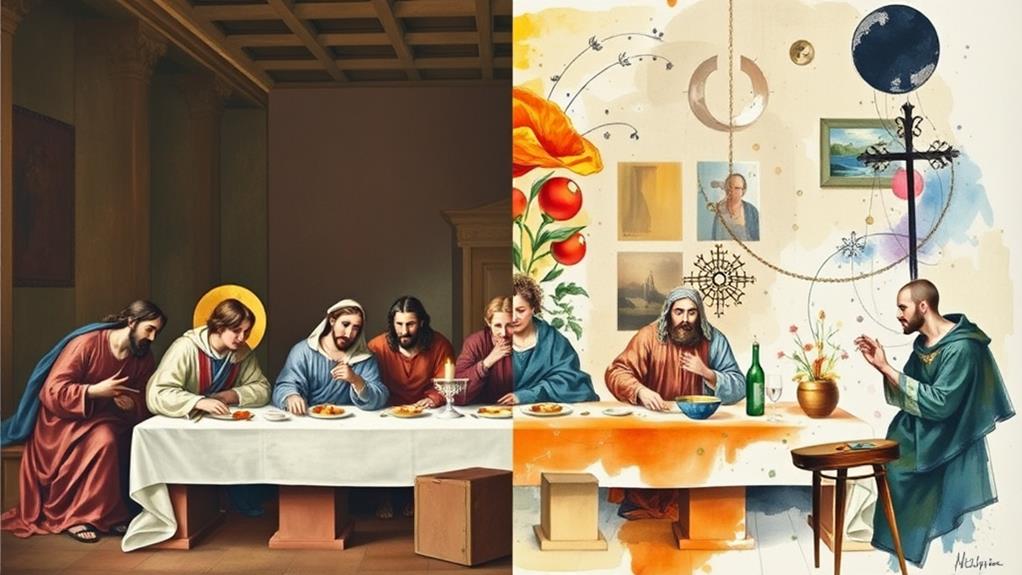
Frequently, I find that the most riveting Last Supper tattoos are those that transcend mere visual representation.
Instead, they convey a deeper personal significance, imbuing the iconic scene with intimate narrative threads. These tattoos serve as a legacy to the power of art to evoke emotional connections and tell personal stories.
They often reveal the wearer’s values, beliefs, and experiences, making the tattoo a unique reflection of their identity.
Some examples of personal significance and storytelling in Last Supper tattoos include:
- Symbolic substitutions: Replacing Jesus or the disciples with personal figures, such as loved ones or role models, to create a sense of closeness and connection.
- Allegorical additions: Incorporating objects or elements that hold personal significance, like a favorite flower or a meaningful quote, to weave a richer narrative.
- Stylistic nods: Adopting a specific art style or aesthetic that resonates with the wearer’s personality, interests, or cultural background, making the tattoo a true extension of themselves.
Frequently Asked Questions
Can I Get a Last Supper Tattoo if I’m Not Religious?
I can get a Last Supper tattoo regardless of my religious beliefs, as the artwork holds secular significance and represents artistic freedom, allowing me to appreciate its cultural and historical importance without religious connotations.
Are Last Supper Tattoos Only for Christians or Catholics?
As I ponder the exclusivity of Last Supper tattoos, I realize that faith symbolism can be divorced from religious affiliation, allowing for artistic appropriation that transcends Catholicism or Christianity, making this iconic image accessible to anyone drawn to its cultural significance.
How Do I Choose the Right Tattoo Artist for a Custom Design?
When searching for a tattoo artist, I prioritize reviewing their portfolio to verify their style aligns with my custom design vision, and I also research their reputation by reading reviews and asking for referrals to guarantee a high-quality, bespoke piece.
Can I Incorporate Personal Symbols or Elements Into the Design?
I can definitely incorporate personal symbols or elements into my custom tattoo design; I’ll discuss my personal icons and symbolic motifs with the artist, ensuring they understand the significance and nuances behind each element to create a meaningful, bespoke piece of body art.
How Long Does It Typically Take to Complete a Last Supper Tattoo?
When I tackle a tattoo, I consider design complexity and tattoo size to estimate completion time; typically, a intricate design on a larger canvas takes around 10-15 hours, while simpler designs on smaller areas require 3-5 hours.
